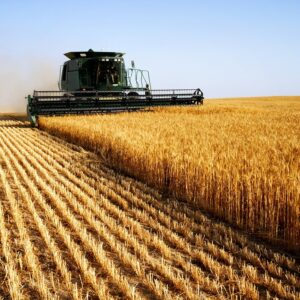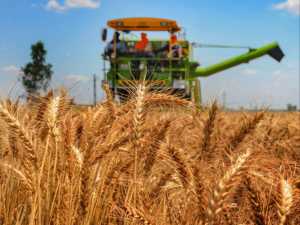Importance of Wheat in Agricultural Economies
Wheat is an important crop and plays a majestic role in the economies of many countries. But wheat is the most basic element of a popular food source all peoples, rich and poor, require. Therefore, the wheat farmer plays an immense role in the lives of every person in the country and is seen as one of the esteemed agricultural activities.
Sustainable Crop Rotation for Wheat Management
In this editorial we highlight the management of the wheat crop in a sustainable crop rotation system to increase the competitiveness of the crop. Although there is not one single best management practice for all situations, this editorial will outline principles of the cultivation and management of the wheat crop, so that applicable management decisions can be made as the specific situation arises.
Profitability in Dry Land Wheat Production

The major consideration in dry land wheat production is profitability. The traditional wheat- fallow-wheat system that had been followed for many years had become unprofitable, mainly due to soil water availability restrictions and increased disease occurrence. This system has also led to degradation of soils via decreased organic carbon (humus), and increased soil acidity and soil erosion. Increased profitability can only be achieved by maximising the yield potential of the crop/soil/ climate combination, while input costs are also strictly managed.
In striving to achieve greater productivity with the available resources invested in crop production, and not necessarily higher total production, it is important to consider a few basic principles of crop management.
• Soil selection is critical, requiring each land to be reviewed individually to realise its potential;
• Analyse soil samples to evaluate the fertility status of the soil;
• Follow an effective liming program;
• Do fertilisation planning including all important plant mineral elements;
• Apply appropriate soil cultivation methods. These include: alleviation of compaction layers, crop residue management, weed control and seedbed preparation, with the main aim of maximizing soil water conservation in the soil profile. Each soil cultivation input must have a specific objective;
• Plant a number of cultivars with a high yield potential and relevant disease and insect resistance; • Calibrate planters to ensure the correct seeding density, fertiliser application and planting depth for seed germination;
• Select the optimal planting time for a particular cultivar, and plant at the recommended seeding density to ensure optimal emergence and seedling establishment;
• Follow an effective spraying programme for control of weeds, insects and diseases during the growing season;
• Timely harvest of the crop and post-harvest storage can impact on optimal yield and grain quality; • Effective marketing of the grain for successful financial management.
Crop Rotation Management
From an economical and agronomical viewpoint it is beneficial to cultivate wheat in a suitable crop rotation system. Grain yields are increased, while weed, insect and disease problems are reduced. Yield limiting factors encountered are:
• Unsuitable soil selection;
• Restricted soil water availability and climatic stresses;
• Low soil fertility and nutritional deficiencies;
• Plant diseases;
• Weed competition;
• Insects;
• Sub-optimal planting dates and cultivar choices;
• Poor seed germination and crop establishment.
These factors arise because of poor cultivation methods, inappropriate soil selection and low water retention practices, soil water accumulation, and crop rotation. Long-term rotations require planning.
Crop Rotation Planning
Good crop rotation planning is the single most important management practice determining yields and profitability. It is an investment in risk aversion. A well planned and managed crop rotation system decreases input costs, increases yields and spreads production risks.
What is the best crop rotation system? There is not one single crop rotation system that will be suitable for all production regions. Every farmer must plan and develop a long-term system that is adaptable and sustainable, incorporating the principles of agronomic management and farm planning. The choice of crop for each field must be based on an objective determination of gross income, input costs, field, and crop rotation history. A crop rotation system for any given situation will be determined by:
• The objectives and attitude of the farmer;
• The different enterprises on the farm and relevant commodity prices;
• The cash flow and economics of the cultivated crops;
• Agronomic management principles;
• Soil depth, structure and texture;
• Soil fertility status and acidity;
• Total rainfall and distribution in the growing season;
• Spectrum of weeds occurring in the fields;
• The rotation of nitrogen fixing and nitrogen dependent crops;
• Occurrence of plant diseases;
• The prevention in the build-up of soil-borne diseases;
• Available machinery and equipment;
• Livestock needs and fodder flow requirements.
Benefits of Sustainable Crop Rotation

Benefits of a sustainable crop rotation system include reducing diseases. A factor emerging as a major threat to wheat yields and thus income in recent years, is the increasing incidence of root diseases. The only practical control strategy is a well-planned and managed crop rotation system, which is aimed at eliminating annual grasses and volunteer wheat, which may serve as a source of inoculum for these diseases at least 12 months prior to crop establishment.
Decrease Weed Burden
Weeds compete with crops for water, nutrients, sunlight, and field space and can significantly reduce yields. Weeds limit grain yields by approximately 20% annually. By alternating crops and rotating herbicides, it is possible to control a wider spectrum of weeds. Effective weed control in one crop often means that the following crop can be grown without the need for expensive selective herbicides. Rotating crops and herbicides reduces the potential for herbicide resistance to develop in target species, for example wild oats. This can also reduce the potential for herbicide residue accumulation in the soil.
Increased Soil Fertility
The aim of a suitable crop rotation is to include a nitrogen-fixing crop (legumes) that replenishes the nitrogen exploited by the grain cropping phases. Yield and grain protein increases in wheat, following legume crops have been widely demonstrated. The accumulation of soil organic material and residual nitrogen in the soil is linked to the recovery of soil structure and increased soil water accumulation capability, which in turn favours improved yields.
Increased Profits and Optimal Management
The inclusion of a legume in the crop rotation system generally increases profitability by increasing grain yields. Economic sustainability is also ensured, because production risks are spread over different crops and growing seasons.
Good yields and profitability can only be achieved through careful planning and management. Higher yields imply higher profits, since production costs per ton of grain declines relatively as yields increase. Avoid having an inflexible approach to crop management. Learn to adapt and revise management strategies as the cropping environment, yield potential, commodity prices and input costs changes.
What determines wheat yield? Total grain yield per hectare is the result of:
• The number of plants per hectare;
• The number of ears per plant;
• The number of grains per ear
• Individual grain weight.
The above-mentioned yield components and eventually grain yield is determined during the three main development phases and relevant growth stages. It is possible that a yield component that kicks in at a later growth phase, partially compensate for reductions in a yield component determined at an earlier development stage. The development stages for the different yield components overlap to some degree in their respective effect on potential grain yield, and they are determined in a definite sequence.

